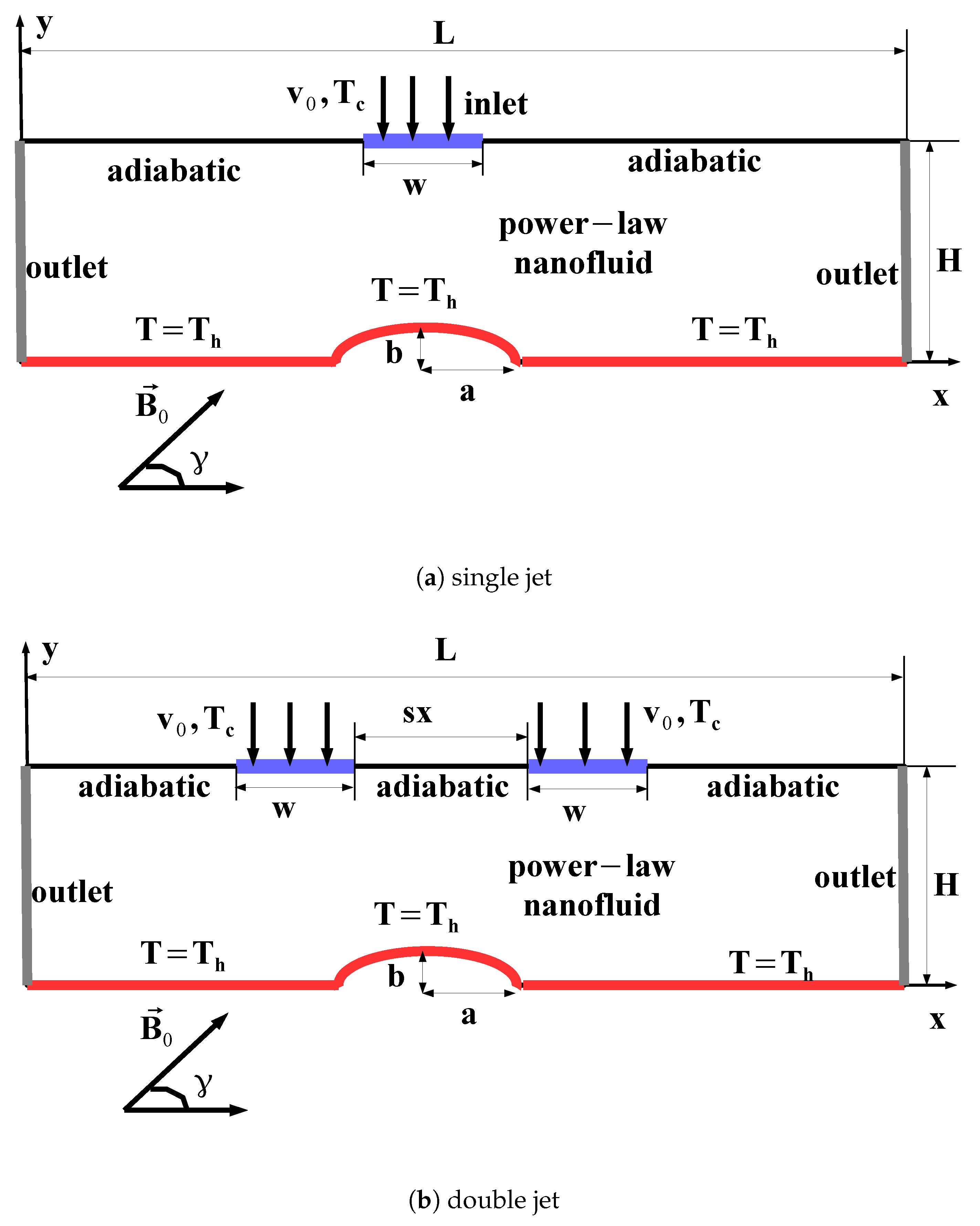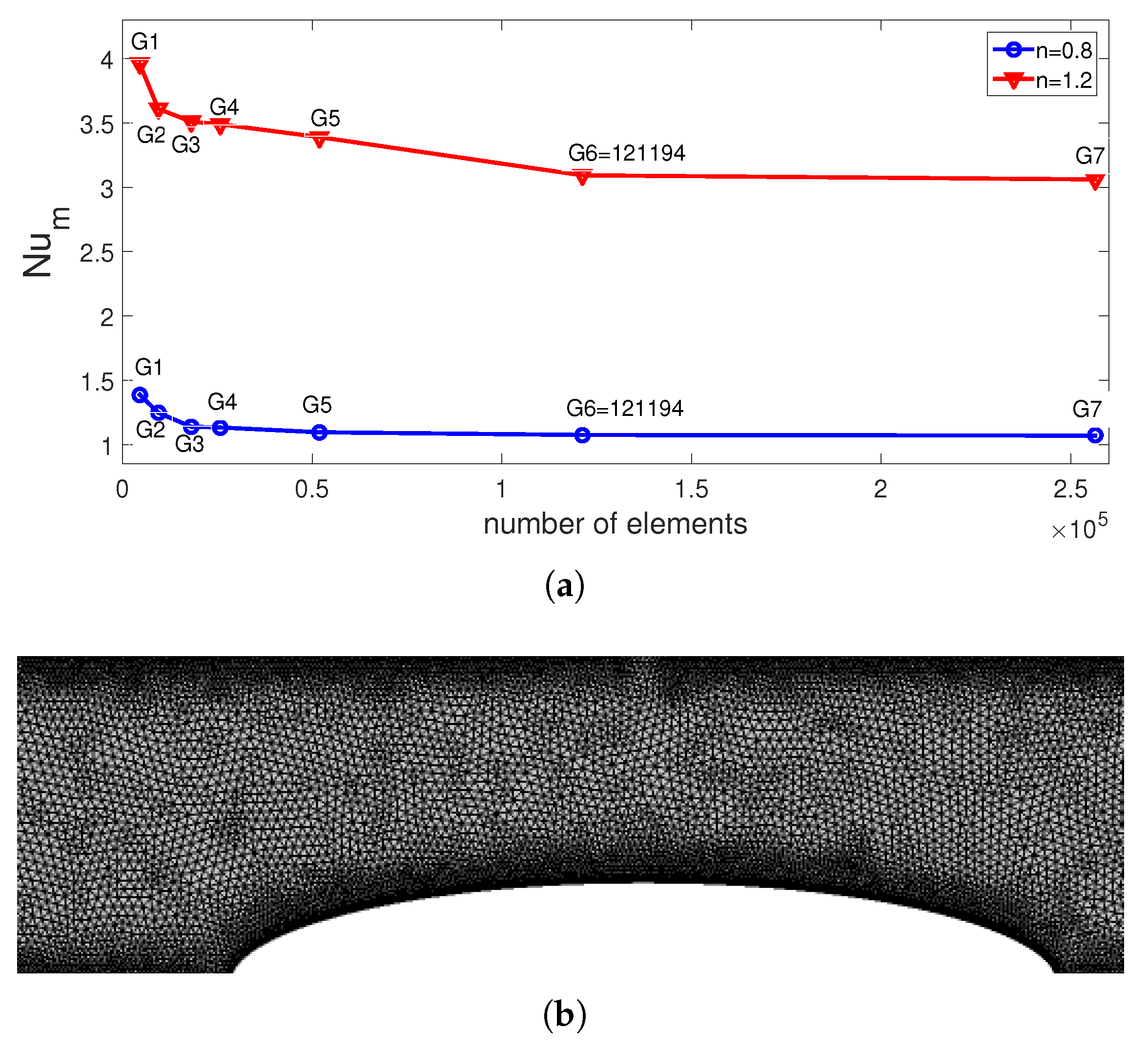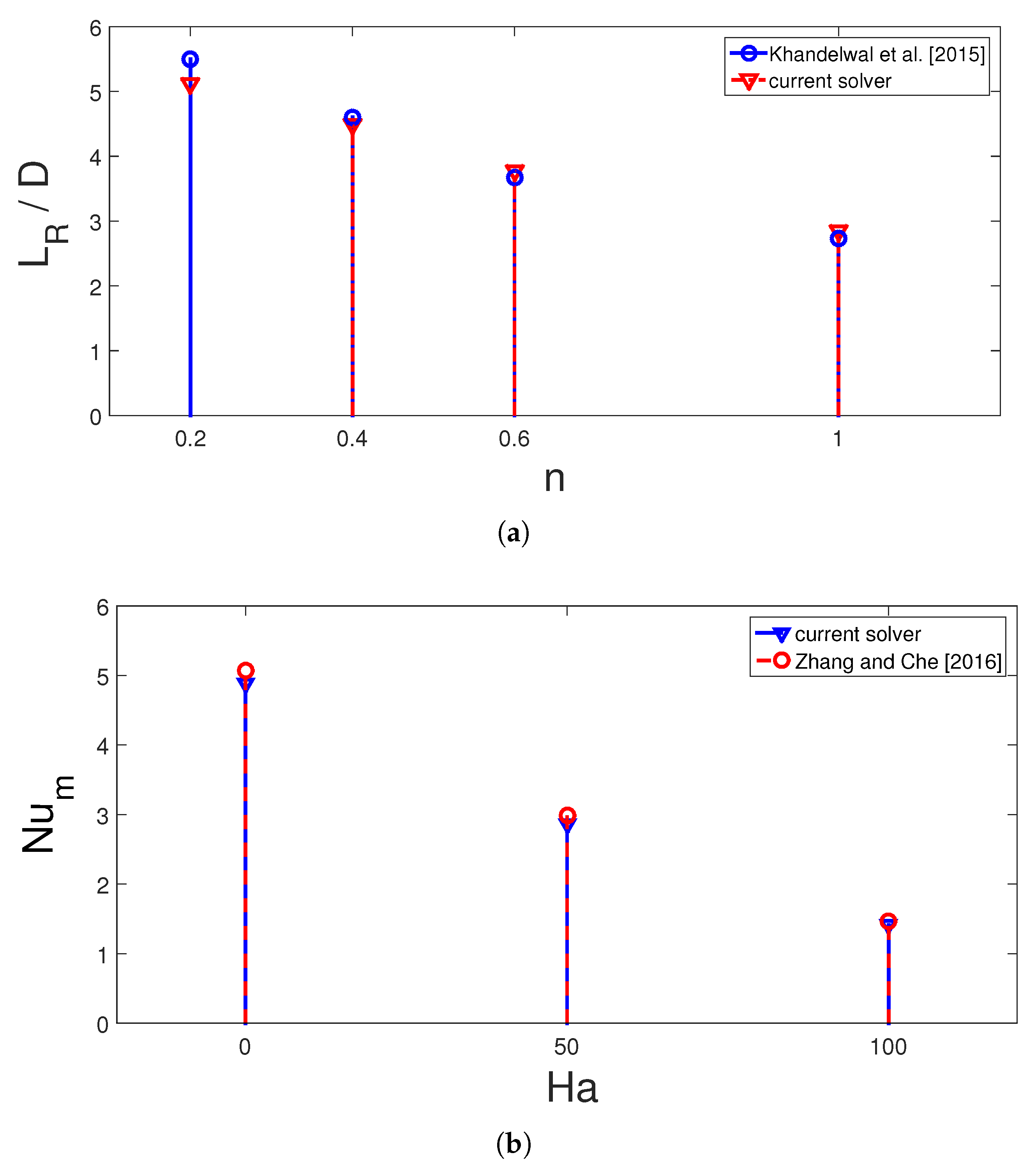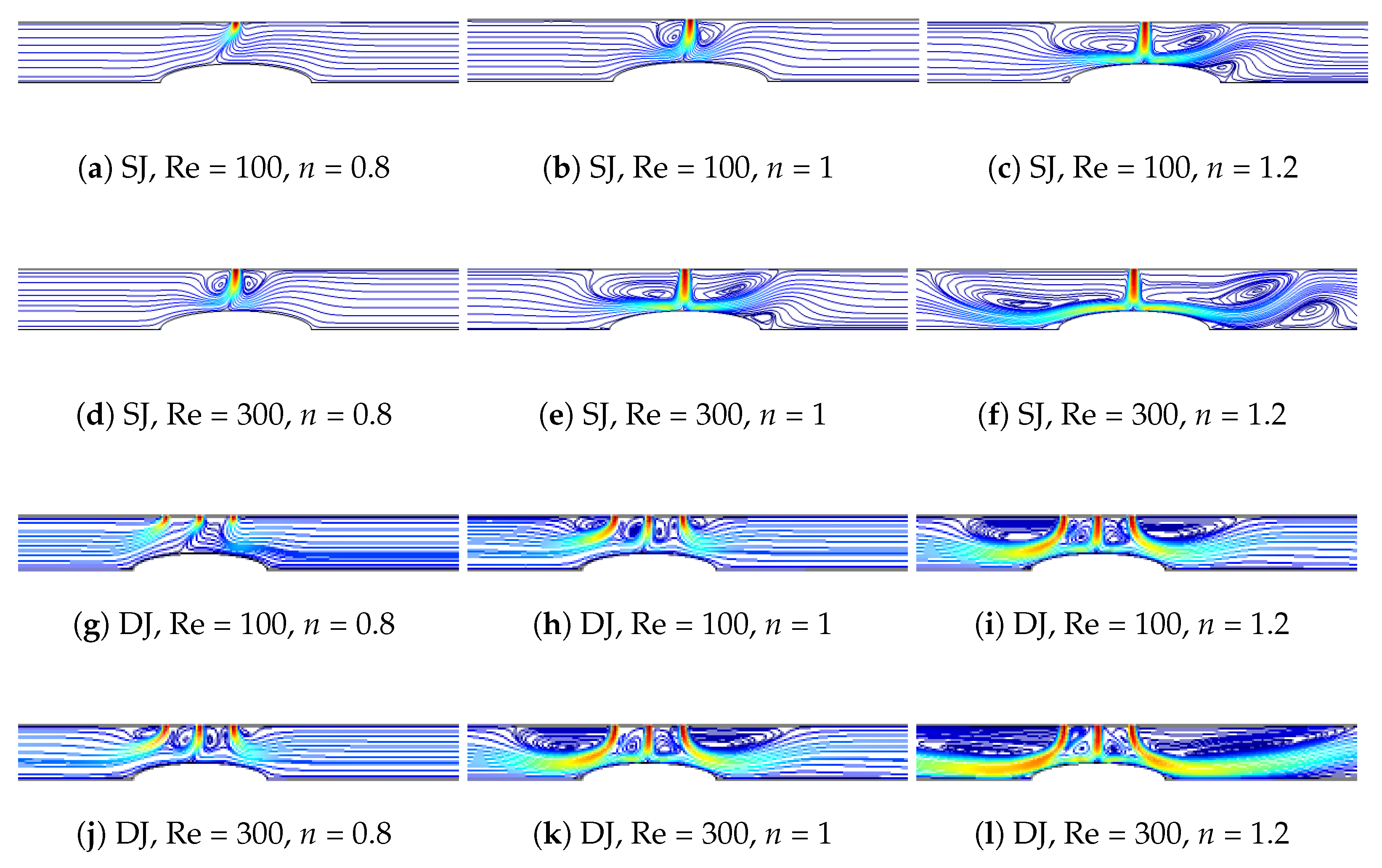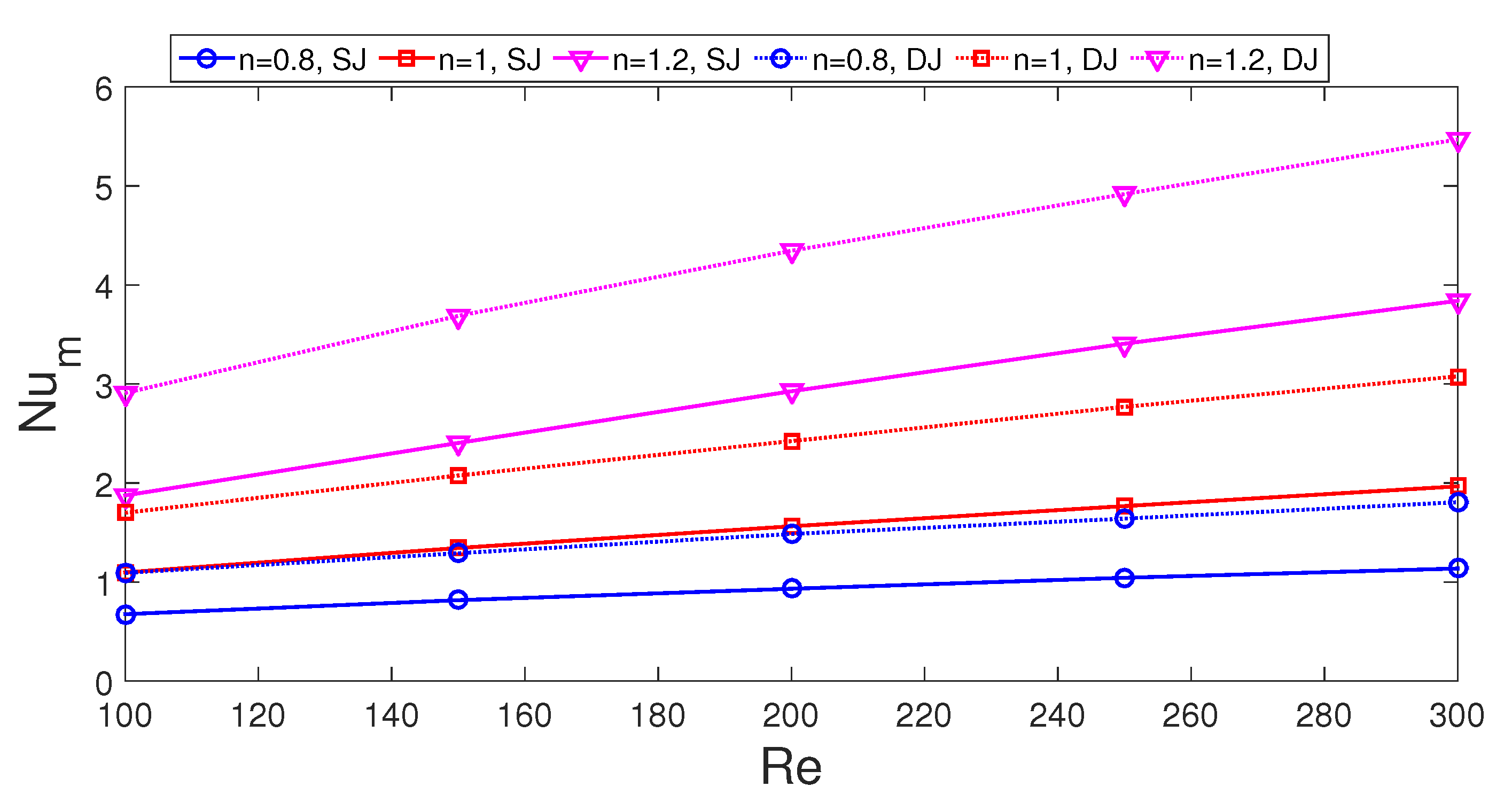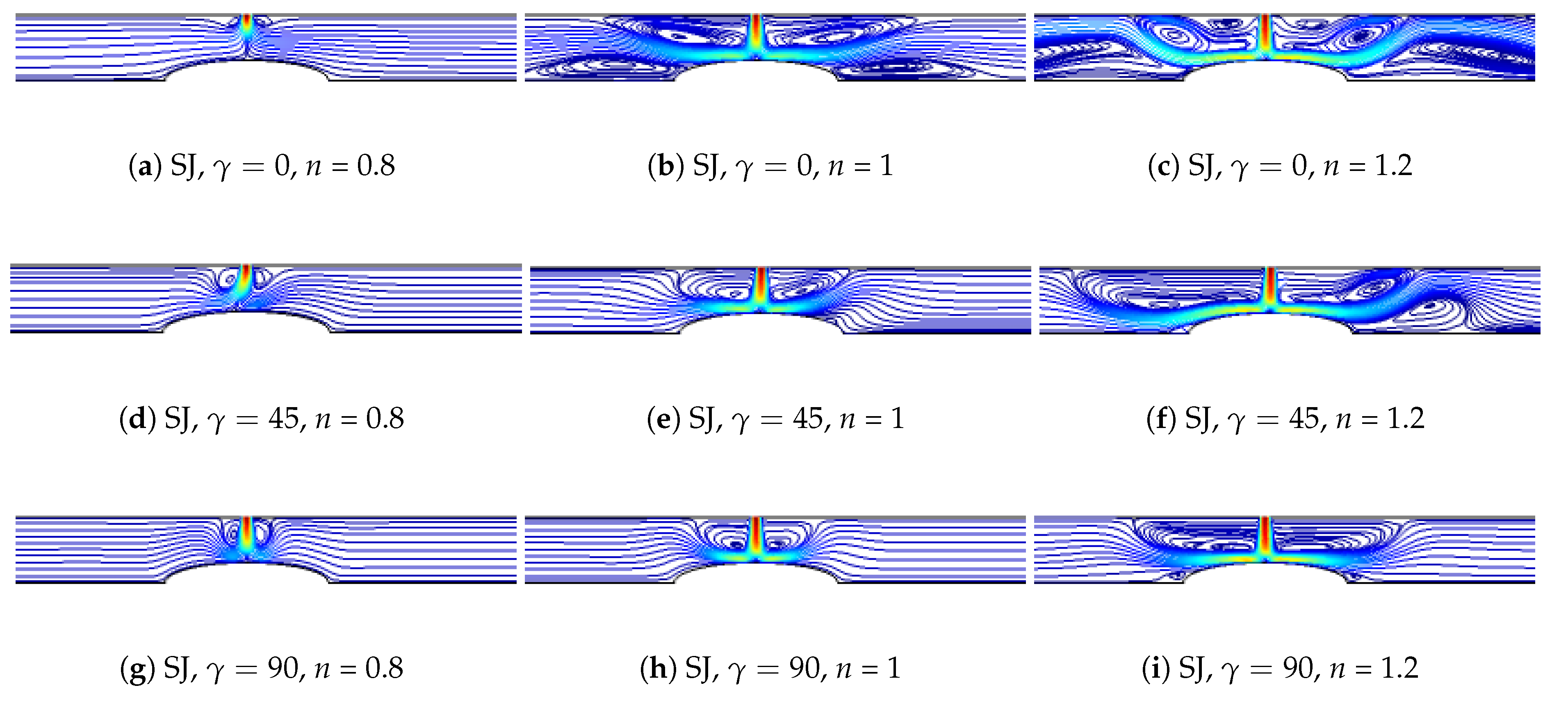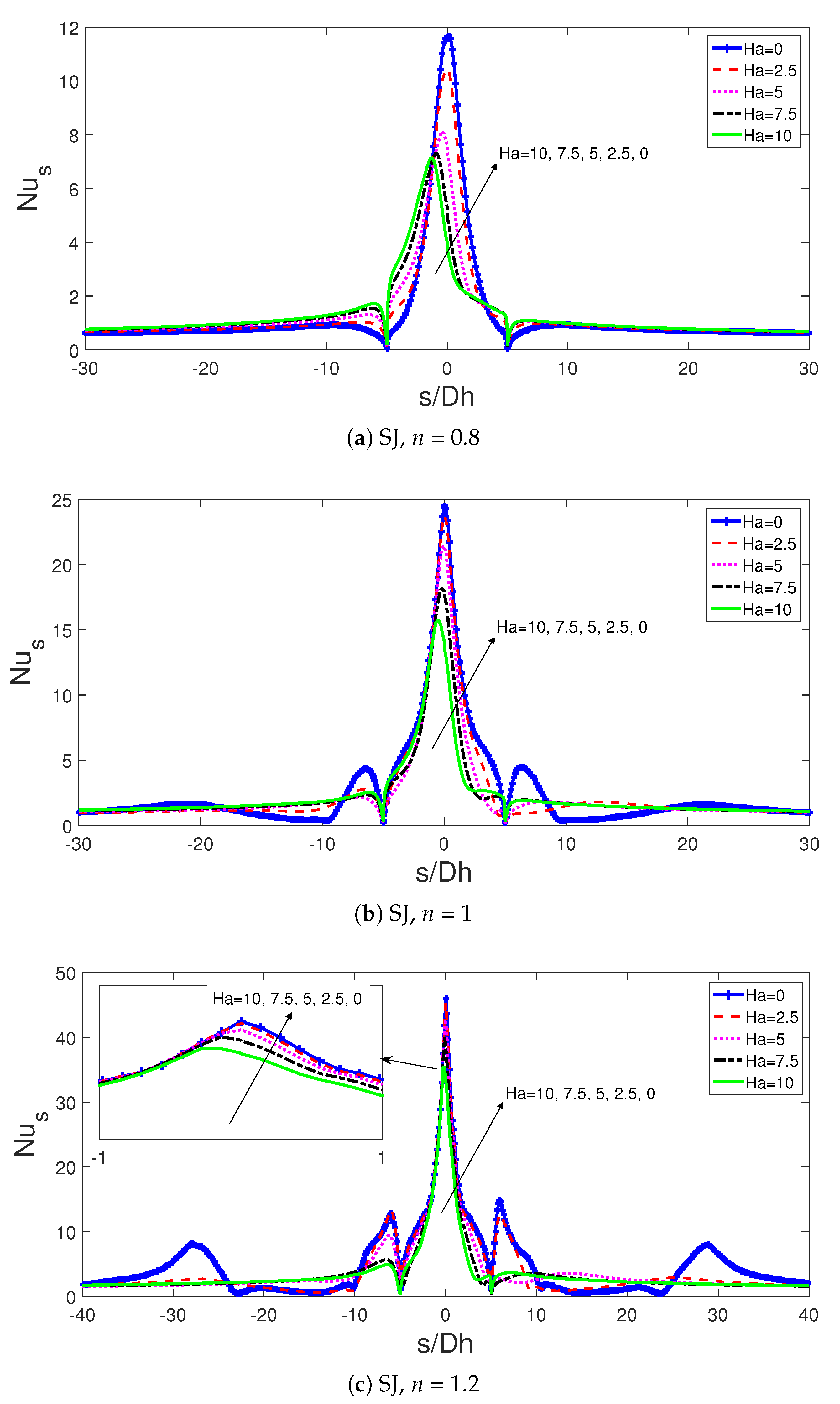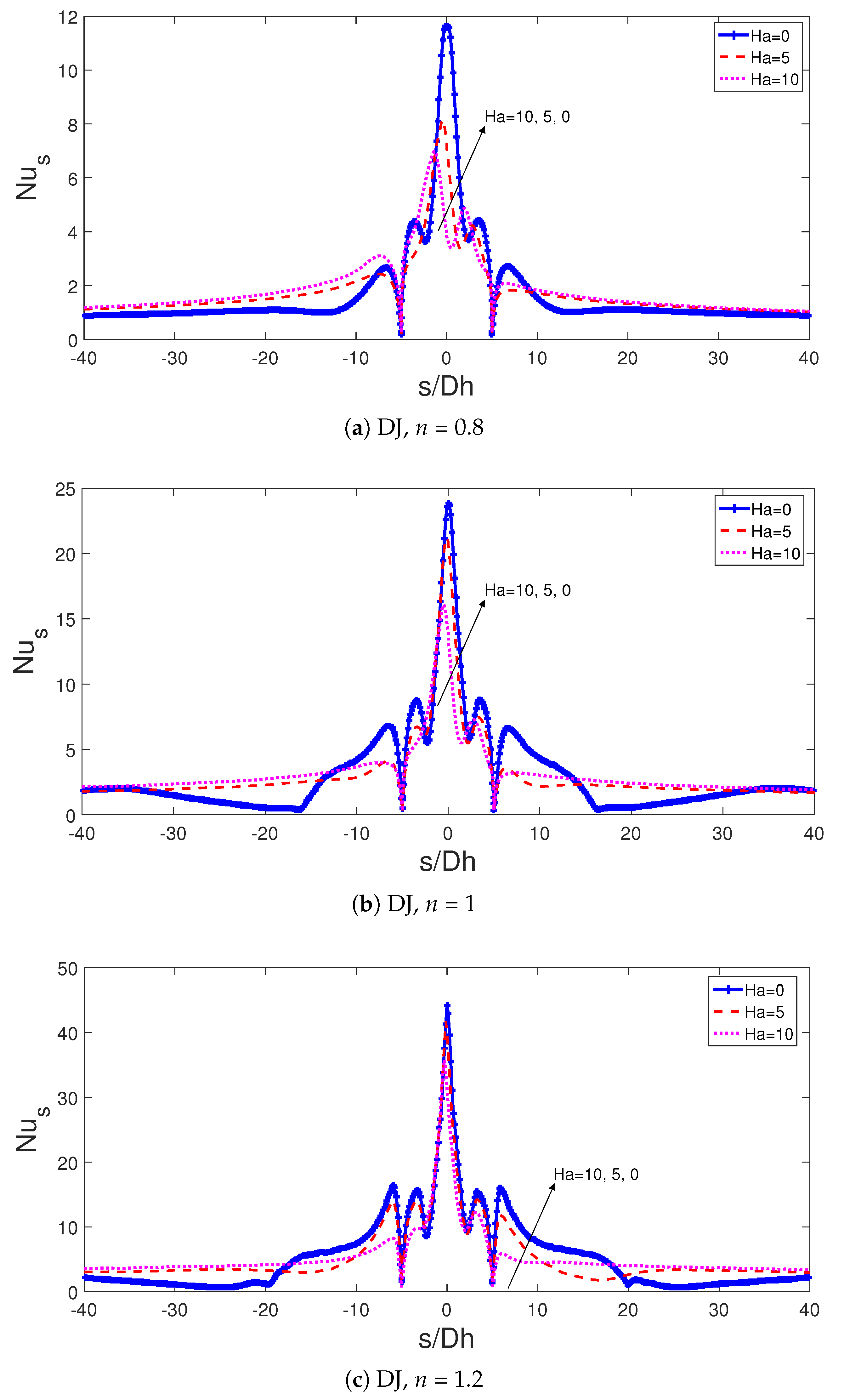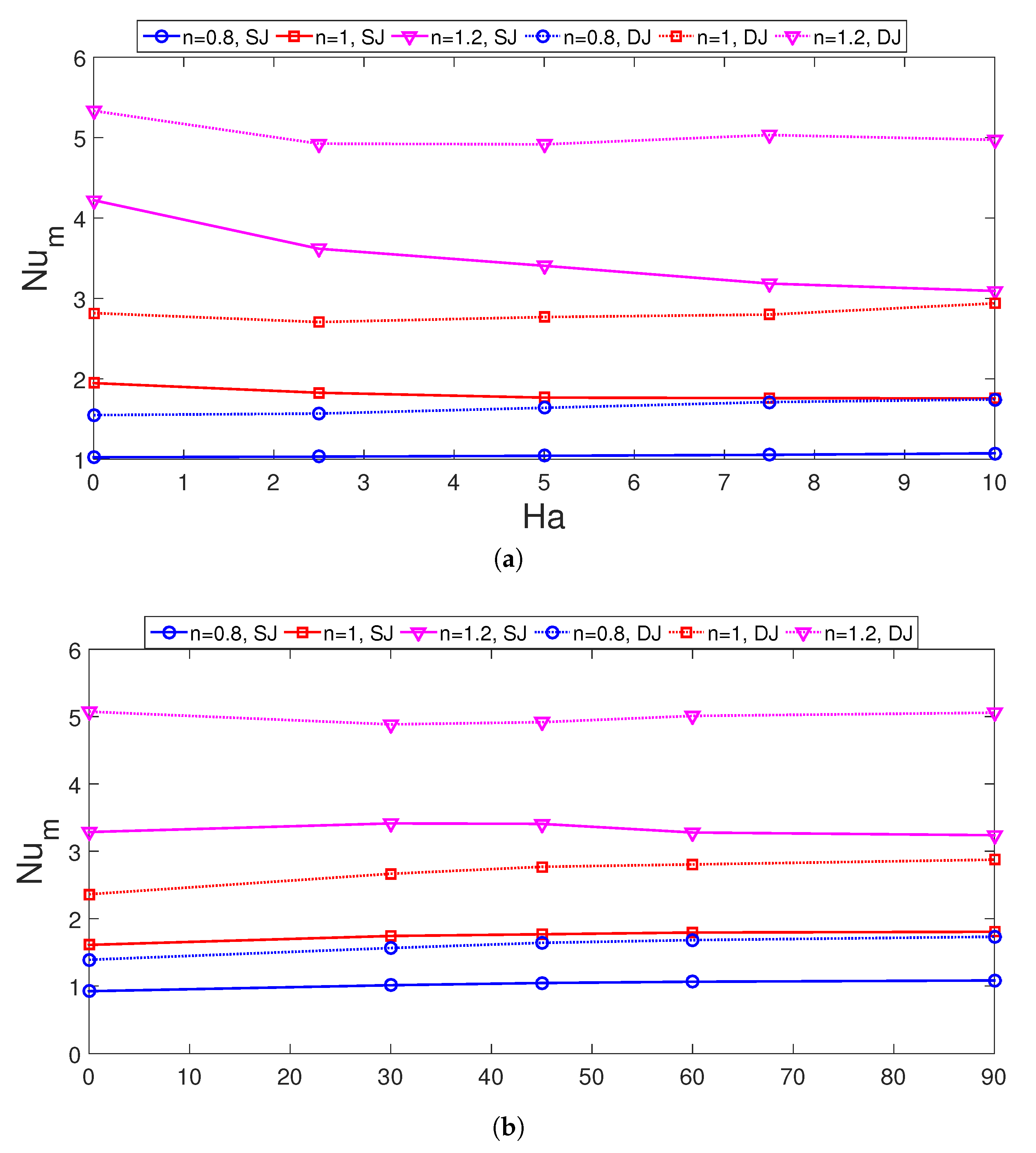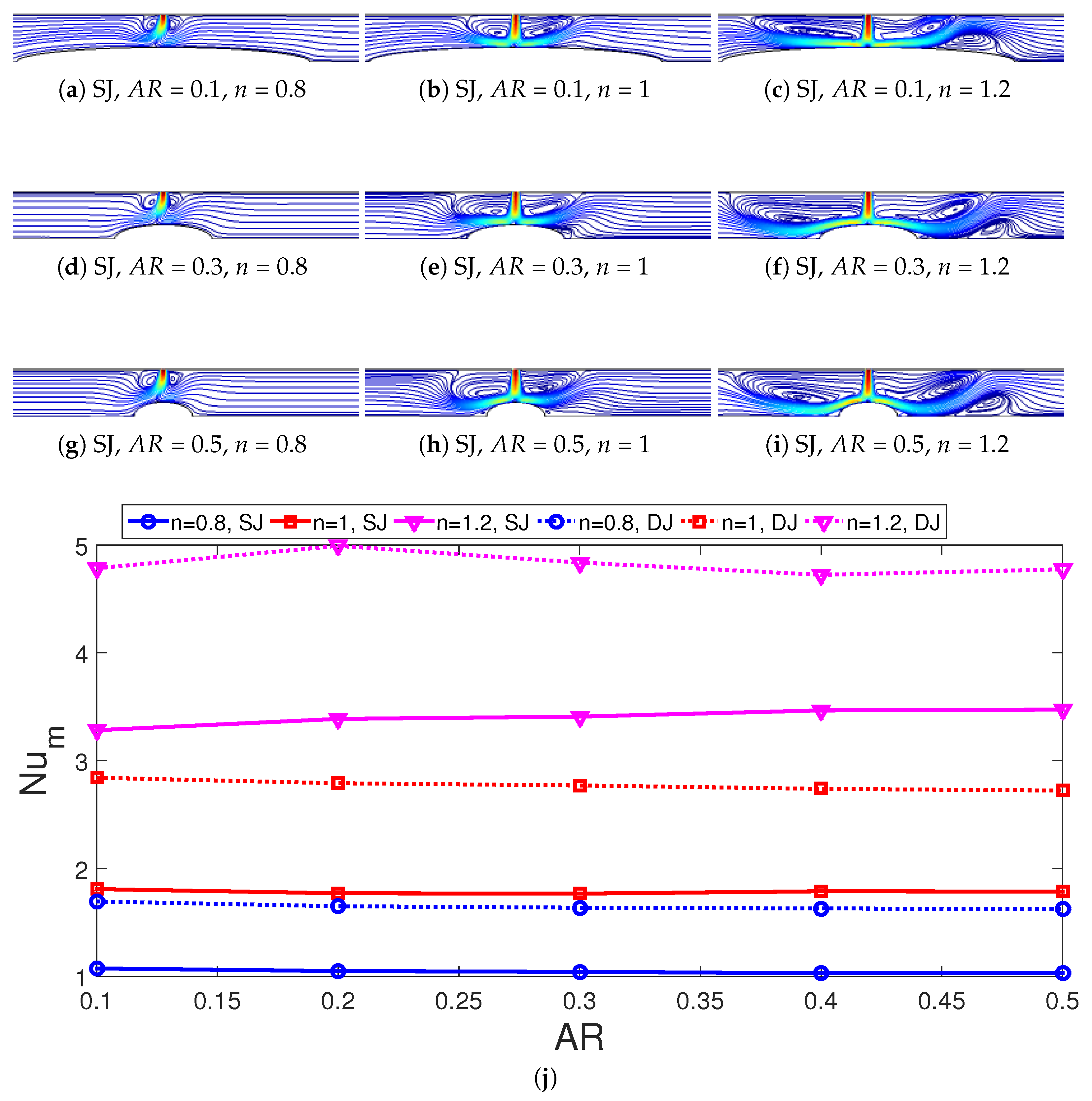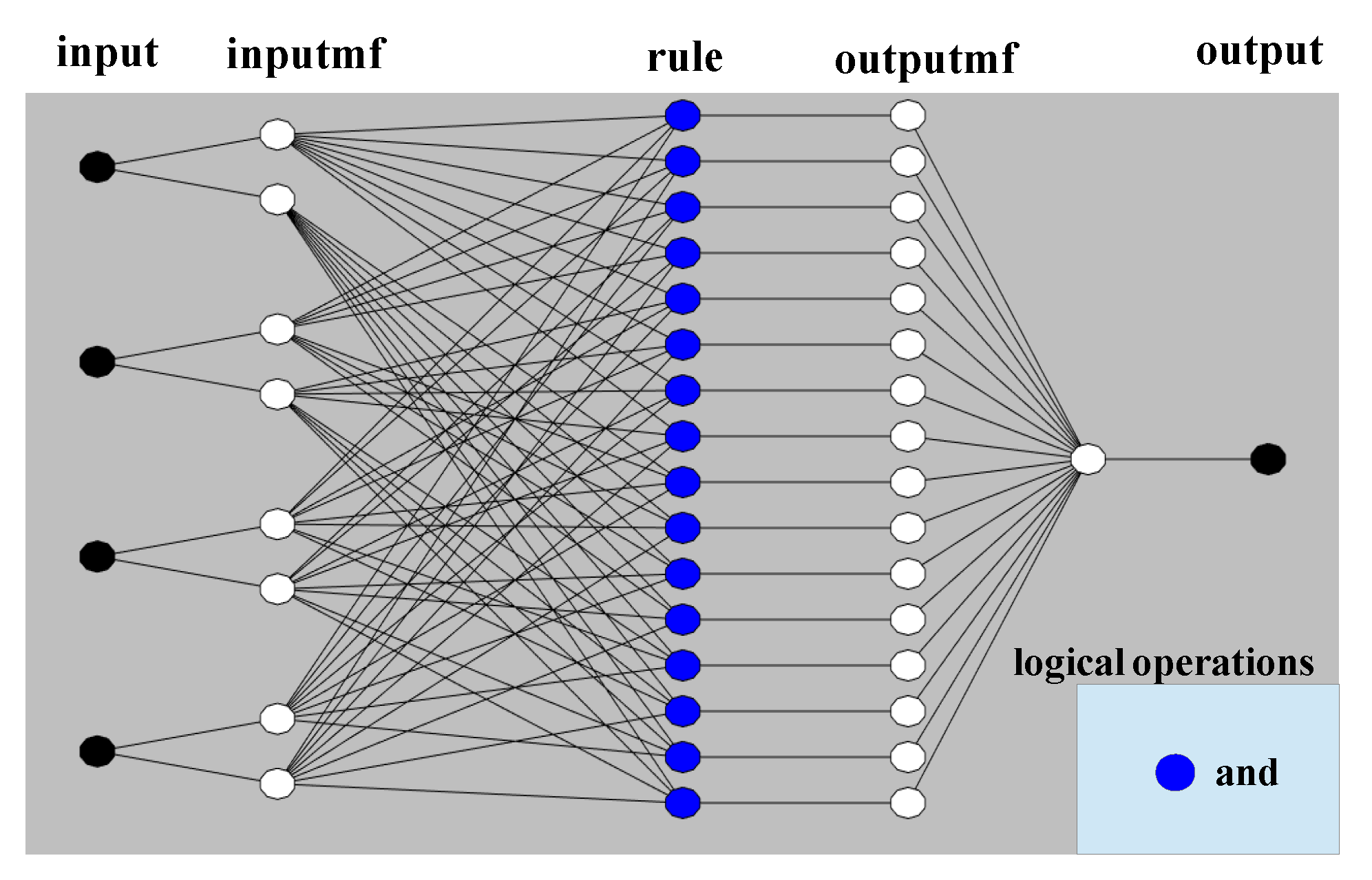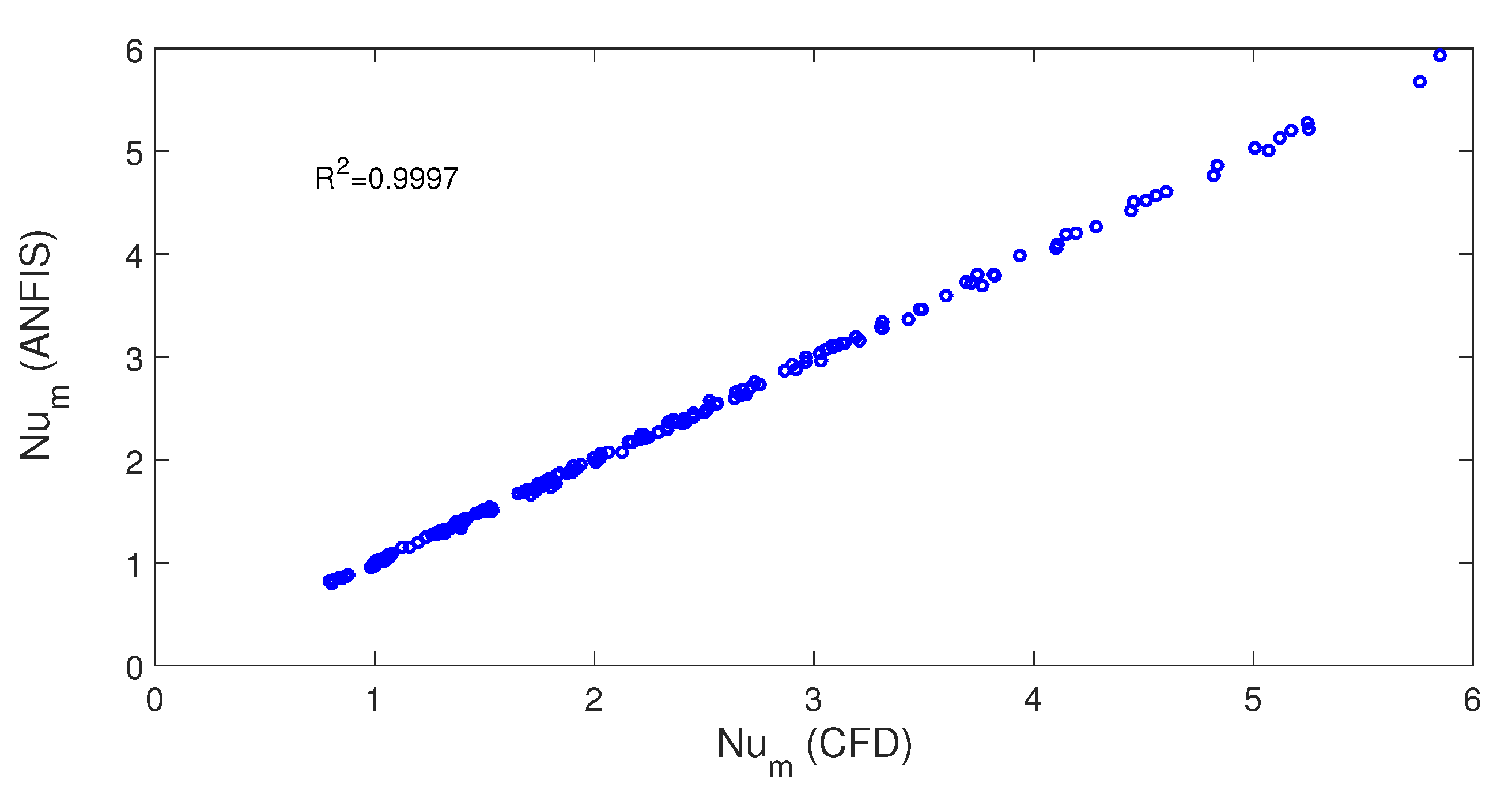1. Introduction
Impinging jets play an important role in various heat transfer (HT) applications such as in textiles, solar energy, turbo machinery, microelectro-mechanical systems (MEMs), and many other systems. In solar applications, photovoltaic (PV) panel thermal management may be performed by using jet impingement (J-I) cooling while in food industry, convective drying performance can be increased with J-I due to the locally higher HT and mass transfer coefficients. In the applications with jet impinging HT, the interaction between the established flow recirculations, pressure gradients, thermal boundary layers and complex geometry will make the analysis very hard to treat it theoretically. Many theoretical, experimental and numerical simulation studies have been performed during the recent years to understand the flow physics and HT mechanisms with impinging jets. Maghrabie [
1] extensively studied the latest advancements in the impinging jet HT with many installation geometries and modified jet configurations. Garimella [
2] analyzed various impacts including geometric factors and velocity profiles for impinging jet HT for confined single and double J-I HT applications. Applications exist that considered the use of impinging jets for thermal management and performance enhancement of PV system [
3,
4,
5,
6]. Droplet jet cooling may be effective in liquid cooling [
7].
The performance of impinging jets in convective HT applications may be improved by using different active and passive HT enhancement methods. In one of the offered methods for HT enhancement, nano-sized particles are used in the HT fluid. The nanofluid (NF) technology applications have been installed in many energy systems for HT enhancement, thermal management and applications vary from refrigeration to thermal energy storage [
8,
9,
10,
11,
12,
13,
14,
15]. During the recent years, many advanced modeling techniques have been developed to simulate the NF behavior in diverse thermal energy configurations [
16,
17,
18,
19,
20]. In convective HT with impinging jets, NFs have also been considered in many studies [
21,
22,
23,
24]. In the experimental analysis of Li [
25], using NFs (Cu-water) increased the HT coefficient by about 52% for submerged jets. Lv [
26], experimentally explored the use of SiO
nanoparticles in water for single J-I HT up to solid volume fraction (
of 3%. Enhancement of convective HT coefficient by about 40% is achieved with Re number between 8000 to 13,000 at the highest
value. In the review work of Mohammadpour and Lee [
27], convective HT with J-I considering NFs have been presented for conventional and swirl type jets. Recent applications and future trends were mentioned with some of the challenges as in agglomeration of nanoparticles and pressure drop features. Many aspects of the NF may be considered such as particle shape, kinetics of nanoparticles agglomeration and non-Newtonian fluid behavior. Convective HT with non-Newtonian behavior of NF has been considered in many studies [
28,
29,
30,
31]. Transient free convective HT in a trapezoidal shaped cavity was considered in Ref. [
32] by using non-Newtonian power law NF. Lower values of power law index were found to be effective on the HT enhancement. Kefayati [
33] analyzed the convective HT and second law in a cavity with magnetic field (MF) effects considering non-Newtonian NF model. The entropy generation rate was found to be dependent upon the power law index. Even though, studies exist that consider the non-Newtonian behavior of fluid with J-I HT [
34,
35,
36], there are a few studies that consider the impinging jet application with non-Newtonian NFs [
37].
In the convective HT with impinging jets, MF effects have been considered in many studies [
38,
39]. There are applications wheres MF effects are present such as in flow control in molten steel in continuous casting process [
40] or MF can be used for convective HT control. The advantageous of using NFs have been considered in many studies where MF effects are present. NFs have been used in several works under the impacts MF in HT applications of J-I systems [
41,
42,
43]. The MF was shown to reduce the fluid motion but at the same time, the potentiality of suppressing the vortices established in the thermo-flow system and performance improvement were also shown in several other studies [
44]. The application of NF with MF effects in HT applications for impinging jets provides more control options for thermal management and HT control. The jet impinging HT has also been considered for various effects of the impinging surface such as elasticity [
45] and curvature [
46,
47,
48,
49].
In the present study, confined slot J-I HT of non-Newtonian power law NF for partly curved surface is analyzed. Even though NFs technology has been used in many impinging jet HT applications and even in some few studies MF effects were considered, non-Newtonian power law fluid effects considering nanoparticles for jet impinging curved target surface including impacts of MF has never been considered in the literature. Confined single jet and double-jet configurations are utilized. As many applications of J-I HT exist in diverse thermal engineering field, the outcomes of the present work will be helpful in the initial design and optimization of convective HT with impinging jet of non-Newtonian power law fluid with MF effects. In the first part, modeling aspects with computational fluid dynamics will be presented. The results will be presented in terms of flow and thermal patterns visualizations, Nu number variations considering various values of Re number, MF strength and inclination, power law index of non-Newtonian fluid, solid volume fraction/size of the particles and curvature ratio of the impinging wall. In the second part of the modeling, convective HT performance estimation by using adaptive neuro-fuzzy interface system (ANFIS) will be performed for various input parameters.
2. Mathematical Formulation
Confined single and double jet (SJ, DJ) configurations are schematically shown in
Figure 1. The target impinging surface is partly curved with elliptic shape having radius of a and b in the axis. Cold fluid with jet velocity of
and temperature of
impinges the curved surface which is at constant temperature of
. The separating distance between the jet inlet ant target plate is
H while the width of rectangular slot is
w and plate length is
L. In the case of DJ configuration, the distance between jets is
. A uniform MF with magnitude
is used for SJ and DJ cases and it makes inclination of
with horizontal axis. The natural convection effects with viscous dissipation are neglected. The induced MF effects, Joule heating and impacts of displacement currents are not considered.
Conservation equations (CEs) of mass, momentum and energy are given in the following for a 2D Cartesian coordinate system [
33]:
In the above given equations MF strength and its inclination are given by and .
Shear stress
is described as [
50]:
with dynamic viscosity
.
For a power law fluid, it is given as [
50]:
with
m and
n representing the consistency coefficient and power law index while
is the shear rate. For a shear thinning (pseudoplastic)
while for shear-thickening (dilatant) fluid
and
represents a Newtonian fluid.
Boundary conditions (BCs) are given as:
At the jet inlet, temperature and velocity are uniform, .
For the bottom plate, temperature is constant and no-slip BC is used, .
The top plate is adiabatic and no-slip BC is considered,
At the side surfaces, x-direction gradients are set to zero,
The relevant non-dimensional numbers are: Prandtl number (Pr), Reynolds number (Re) and Hartmann number (Ha) which are defined as in the following [
33,
51]:
As the heat transfer fluid (HTF), alumina-water NF is used with thermophysical properties given in
Table 1. Advanced correlations which are Corcione’s correlations are used for the alumina-water NF effective thermal conductivity (
) and viscosity (
). They are given with the following relations [
52]:
The nanoparticle Reynolds number (
) and molecule diameter of base fluid (
) are described as:
In the above relations, M, NA, represent the base fluid molecular weight, Avogadro number and Boltzmann’s constant while is the diameter of nanoparticle.
Galerkin weighted residual finite element method (FEM) is utilized as the solver procedure. In this formulation, weak form of the governing equations is considered while residuals (
R) is set to be zero in an average manner:
with
as the weight function. Lagrange FEM of various orders are used for the field variable (
) approximations as:
In the above representation, denotes the shape function while F is the nodal value. The convergence criterion is set to for the which the converged results are achieved. The PARDISO direct solver is utilized.
Mesh independence tests are performed to find the optimal mesh configuration. Test results with coarse grid (G1, 4551 number of elements) to extra fine grid (G7, 256,324 number of elements) are shown in
Figure 2a at two power law indices. G6 (finer grid, 121,194 number of elements) is selected for the subsequent computations. Grid refinements were made near the walls and curved parts. Its distribution in the vicinity of the curved parts is given in
Figure 2b.
Numerical code is validated by using results in different sources available in the literature. In the first work, local Nu number comparisons are made for the confined slot jet impingement HT under laminar flow conditions at several locations in
Table 2 for Re = 100 as given in Ref. [
53]. The overall agreement is satisfactory. In another work, comparisons of stagnation point Nu number are presented in
Table 3 for confined slot jet impingement HT for different Re numbers available in the Refs. [
54,
55]. The highest deviation is found as 3.28% at Re = 100.
Impacts of using non-Newtonian power law fluids on the flow separation is considered for shear thinning fluid as in Ref. [
56] for power law indices between 0.2 and 1. A correlation in the exponential form is proposed which depends upon the Re number and power law index. Comparison results of reattachment length with different power law indices at Re = 100 are given in
Figure 3a,b. The highest difference of 5% is obtained with
. Validation study was also performed for case with MF effects. Convective HT with MF effects was considered and impacts of MF strength on average Nu comparisons are given in
Figure 3b for fixed value of Grashof number at
. The highest deviation is found to be below 5% between the results of [
57].
3. Results and Discussion
In this study, confined single and double jet impingement heat transfer for a non-Newtonian fluid under the effects of MF are analyzed. The MF is uniform throughout the domain while fluid type is power-law NF. Both SJ and DJ configurations are studied. The numerical analysis is performed for different values of Re number (), Hartmann number (), inclination of MF (), aspect ratio of the curved surface (), power law index (), nanoparticle volume fraction () and particle size in nm ().
Impacts of Re number of the flow pattern (FP) variations are shown in
Figure 4 (Ha = 5,
= 45,
= 0.25,
= 0.04,
= 20 nm) for SJ and DJ configurations. At very low Re number for shear thinner fluid, due to presence of MF and its impact of the dampening of the fluid motion, no vortices are appeared. As the value of Re number is increased, flow recirculations are established near the inlet due to entertainment and confinement. For the shear thickening fluid, this vortex further increases in size due to the increased fluid velocity while at the wall jet region over the curved surface a recirculation zone is also established. Similar observations are seen for the the DJ configuration, but the occurrence of the vortices in between the jets is apparent. For shear thickening fluid at Re = 100 and Re = 300, the occurrence of secondary vortex on the bottom wall is distinguishable between the SJ and DJ configurations. Local Nu rises with higher power law index for both SJ and DJ cases while the secondary local peak in the Nu is also apparent for fluid with
n = 1.2 at Re = 300 (
Figure 5). In the case of DJ impingement, first three main peaks correspond to the impinging jet locations while other peaks denote the reattachment of the secondary vortex point on the bottom wall and size of those peaks increase with higher Re number. Average Nu number becomes higher for the DJ configurations as compared to SJ case. The discrepancies between the average Nu number of the DJ and SJ configurations become 61.9%, 54.9% and 55% for shear thinning fluid (
n = 0.8), Newtonian fluid (
n = 1) and shear thickening fluid (
n = 01.2) at Re = 100 while these values become 58.7%, 56% and 42.8% at Re = 300. When Newtonian fluid (
n = 1) is taken as reference fluid, discrepancies in average Nu between different fluid types become
and 71.5% for
n = 0.8 and
n = 1.2 at Re = 100 with SJ configurations and these values become
and 98% at Re = 300. In the SJ configuration, fluid with higher power law index resulted in higher variation in the average Nu as compared to Newtonian fluid and amount of increase depends upon the value of Re number. Similar observations are achieved for DJ case while amount of increment in the average Nu becomes 71% and 77.7% for
n = 1.2 at Re = 100 and Re = 300 when compared to Newtonian fluid configuration (
Figure 6).
A uniform MF with inclination is imposed in the non-Newtonian fluid flow domain. The presence of the MF resulted in fluid flow motion dampening while the established recirculation zone size reduces as well. In the absence of MF with Newtonian fluid, vortices near the inlet and on the bottom wall occupies a large portion. As the power law index is increased to
n = 1.2, near the inlet vortices form the multi-cellular flow structure while on the bottom wall the established recirculation zone size increases further. However, for shear thinning fluid (
n = 0.8), the vortex size reduces in the inlet region while the bottom wall secondary vortices disappear due to the reduced fluid velocity in the absence of MF effects. For DJ configuration at the highest power law index, two vortices are formed in between the jets while the bottom vortex disappears and the number of vortex near the inlet jets becomes two. As the MF is imposed, the vortex sizes near the inlet jet and on the bottom wall reduces for both SJ and DJ configurations. The vortex size and numbers can be controlled with MF strength and power law index and for the case with highest MF strength, no vortices are formed for shear thinning fluid. The MF inclination also plays an important role in controlling the vortex size as shown in
Figure 7 at Ha = 5. The inlet vortex size diminishes with higher MF inclination angles for Newtonian and shear thinning fluid while the impact is reverse for shear thinning fluid where small vortcies are established near the inlet jet for this fluid type. The suppression of the bottom vortcies with higher values of
is apparent for power law index of
n = 1 and
n = 1.2 (
Figure 8). Impacts of MF strength on the local Nu number distribution for three different power law index are given in
Figure 9 for SJ and in
Figure 10 for DJ configurations. Local peak of Nu is reduced with higher MF strength and additional local peaks are observed as the power law index is increased. These peaks are also damped with higher values of Ha number. There is also a shift in the local peak of Nu number with higher MF strength especially for the shear thinning fluid. Similar observations are obtained for the local peaks of the Nu number with varying MF strength. The impact of MF on the average Nu variation depends on the fluid type. When MF is imposed at the highest strength as compared to non-MF case, there is 26.6% and 7.5% reduction in the average Nu number for shear thickening fluid with SJ and DJ configurations while the average Nu rises by about 4.78% and 12.58 % for shear thinning fluid where the heat transfer rate is low. As Newtonian fluid is considered, there is reduction of 10.48% in the average Nu with highest MF strength for SJ case while it is increased by about 4.6% for DJ case. The suppression of the secondary peaks due top the bottom vortex and reduction of the impinging point Nu number with MF strength in DJ case determined the amount of enhancement or reduction in the average Nu number for power law indices
n = 1 and
n = 1.2. The highest value of average Nu with varying MF inclination is achieved at different
depending upon the fluid type and jet configuration.
When shear thickening fluid (
n = 1.2) is considered, the highest Nu is obtained at
for SJ case while it is minimum for DJ case. For SJ configuration, there is 7.3%, 11.8% and 1.5% variations in the average Nu number with fluids at power law index of
n = 0.8,
n = 1 and
n = 1.2 when horizontal and vertical alignment of MF are compared while these values become 24.6%, 20.7% and 0.5% for DJ configuration (
Figure 11).
The partly curved wall size impacts on FPs for SJ case and average Nu variations for SJ and DJ cases are shown in
Figure 12a–i and in
Figure 12j. The curvature is an ellipse while the effects are characterized by aspect ratio (AR) which denotes the ratio of the radius in the minor and major axis. For the fixed value of minor axis radius, increasing the AR reduces the size of the ellipse in the wall jet direction. The fluid impinges on the curved surface and a separated flow region is established in the wall jet region over the curved surface for shear thickening fluid at
= 0.1 while it occurs away from the curve surface near the flat bottom wall for
= 0.5. For shear thinning fluid, recirculations on the partly curved wall are not appeared for all values of
. The recirculation near the inlet are affected by varying the
values especially for power law index of
n = 1.2 which is due to the occurrence of the secondary recirculation zones. Average Nu variation is 5.8% for
n = 1.2 with SJ configuration and it is 5.43% for
n = 0.8 with DJ case when lowest and highest
values are considered.
Adding nano-sized particles and varying its size changed the convective heat transfer features for fluids with different power law indices as shown in
Figure 13a,b. The increment amount with
depends upon the jet configuration and fluid type. Configurations with DJ and shear thinning fluid (
n = 0.8) resulted in the highest HT increment which is 14.7% as compared to pure water at the same power law index while this value is 14.10% for SJ configuration. However, for shear thickening fluid, the potentiality of using NFs in HT enhancement becomes lower which is 12% for SJ and 13.4% for DJ cases. It is advantageous to use NFs in DJ configurations but the difference in HT enhancement with NF is below 2% when compared to SJ case at the same
. Higher nanoparticle size resulted in lower values of average Nu and the amount of decrement is between 6% and 7% for SJ and DJ configurations with various power law indices.
ANFIS (Adaptive Neuro-Fuzzy Interface System) Based Modeling
Convective HT performance is predicted by using ANFIS based modeling approach for SJ configurations. Soft computing methods are frequently used in thermal engineering systems and renewable energy systems. There are diverse methods and ANFIS is a powerful technique that uses the artificial neural networks (ANN) with fuzzy logic [
58,
59]. In the ANFIS modeling approach, fuzzy interface system has rule base with membership functions and has a reasoning mechanism which performs inference operation to get the model output. Let us consider
,
as the input and y as output of a a fuzzy inference system while the rule base contains two fuzzy if-then Takagi and Sugeno’s type rules [
58,
60]:
In the above representation, fuzzy sets are denoted by and while denotes the output within the fuzzy region. The parameters and are obtained from training phase.
Different layers are available in the ANFIS modeling [
61]. Input variable is blurred with the membership functions in the fuzification layer while the membership grade for the input variable is formed. In the second layer, fixed nodes and the product is the firing strength of the rule as denoted by:
The normalized firing strength is got in the third layer as:
The outputs of each node is got with multiplying the normalizing firing strength and first order order polynomial rule as in the defuzzifying layer as:
In the last layer, the overall output is got while the parameters of first and fourth layer are adjusted in the training phase with a learning algorithm. A learning algorithm which is a hybrid type is used.
The model quality can be measured by using mean square error (MSE), mean absolute error (MAE) and coefficient of determination (
). The MSE and
are defined as in the following:
while the coefficient of determination (
) is stated as in the following:
with
M representing the simulation data set number while
denotes the average value.
In the modeling with ANFIS, four inputs and one output are used by using the parametric data from CFD computations for SJ configuration. The input variables are the Reynolds number (Re,
), Hartmann number (Ha,
), power law index (n,
) and aspect ratio of the curved wall (AR,
). Five different values for each of the input parameters are considered with
and
= 20 nm. In total, 625 numerical simulation data are used and number of training and testing data set to ANFIS are 438 and 187 (Random data division is used). ANFIS model structure with 4 inputs and 1 outputs are shown in
Figure 14. ANFIS model parameters are given in
Table 4. Model performances for training and testing are given in
Table 5 with low values of MSE and
values are closer to 1.
Figure 15 shows the average Nu comparisons between the ANFIS and CFD for validation. The generated surface plots with ANFIS for variation of average Nu with respect to changes in various inputs, input 1-Re number, input 2- Ha number, input 3- power law index, input 4- aspect ratio) are shown in
Figure 16. Higher accuracy and predictions for convective HT performance are achieved with ANFIS based modeling.
